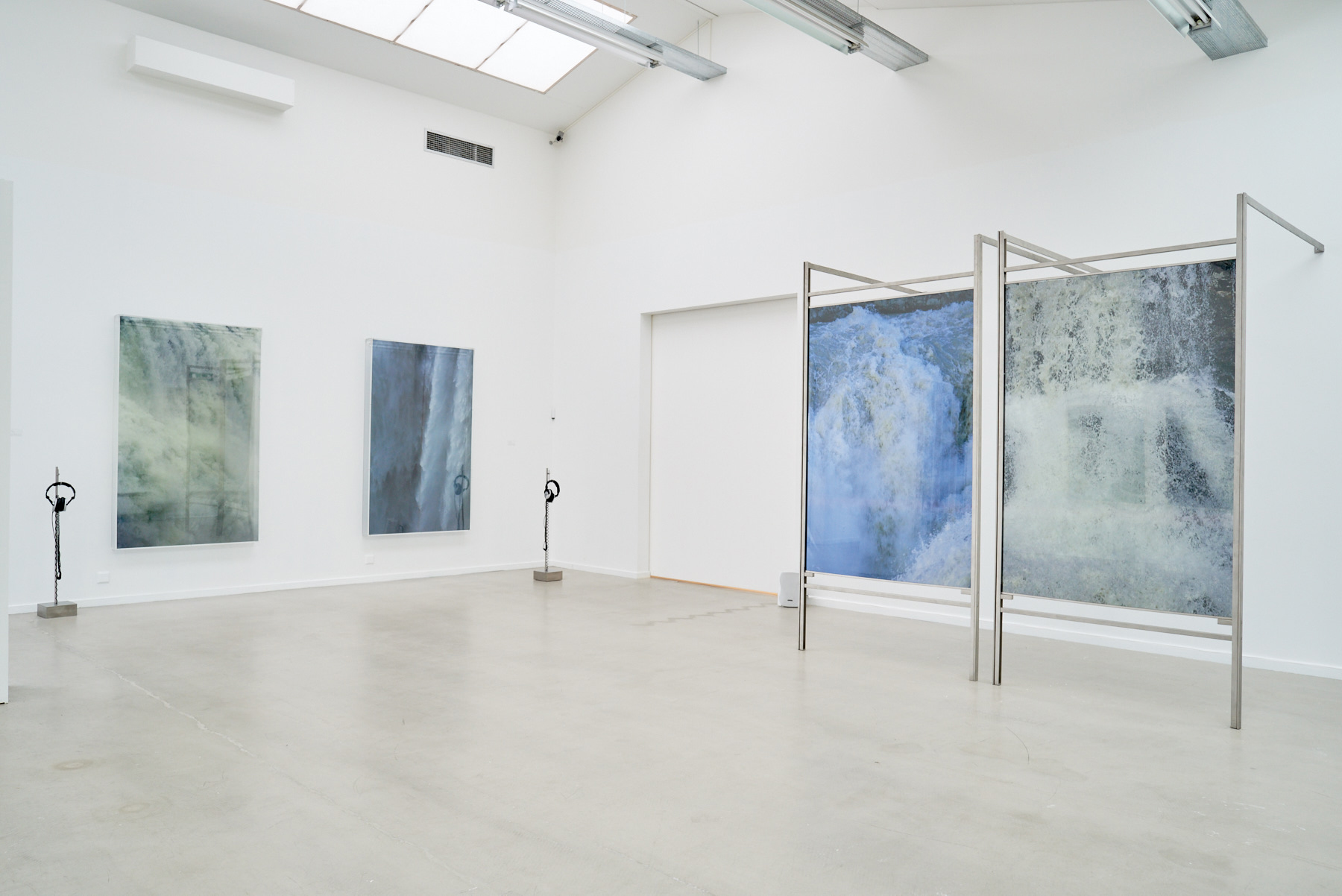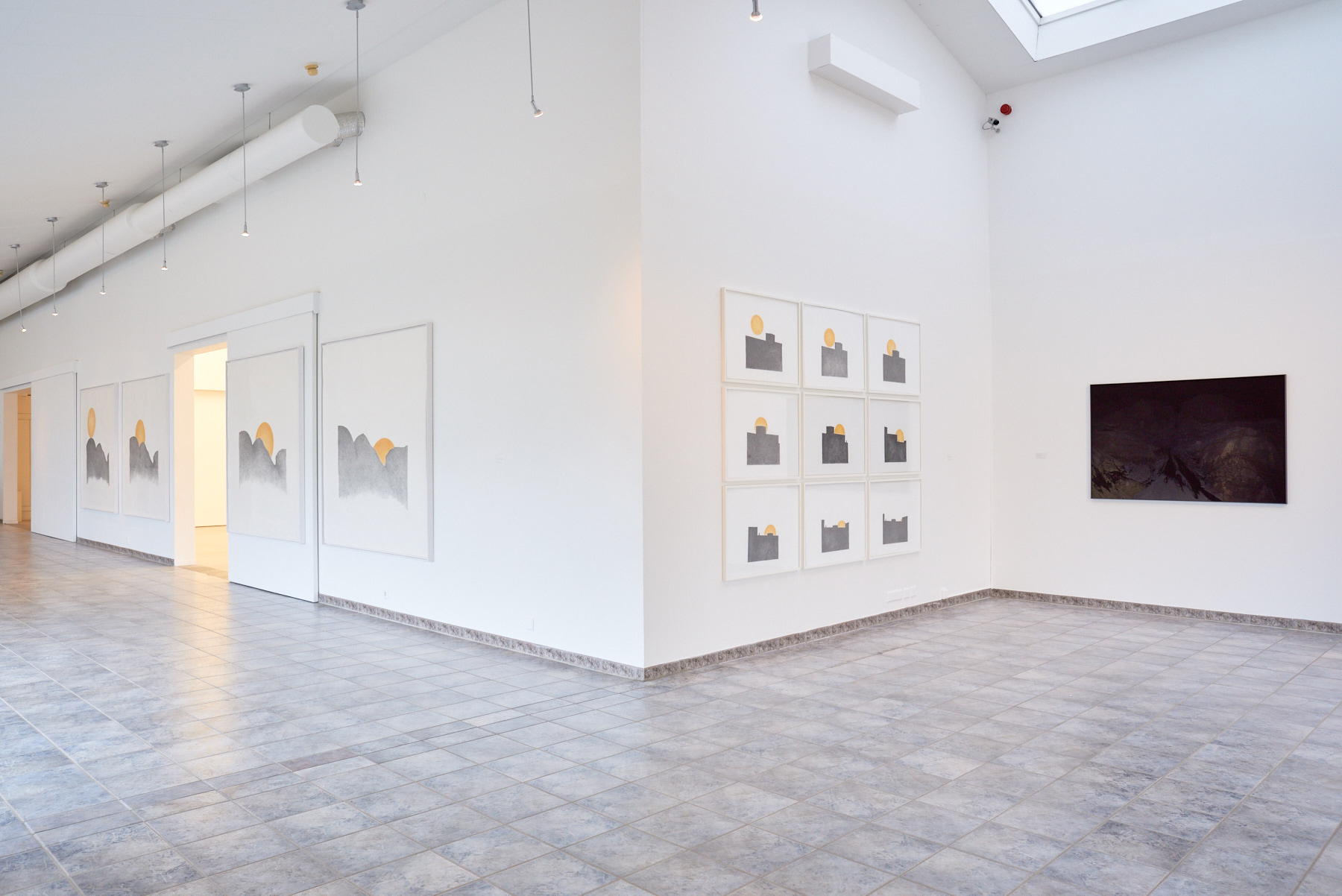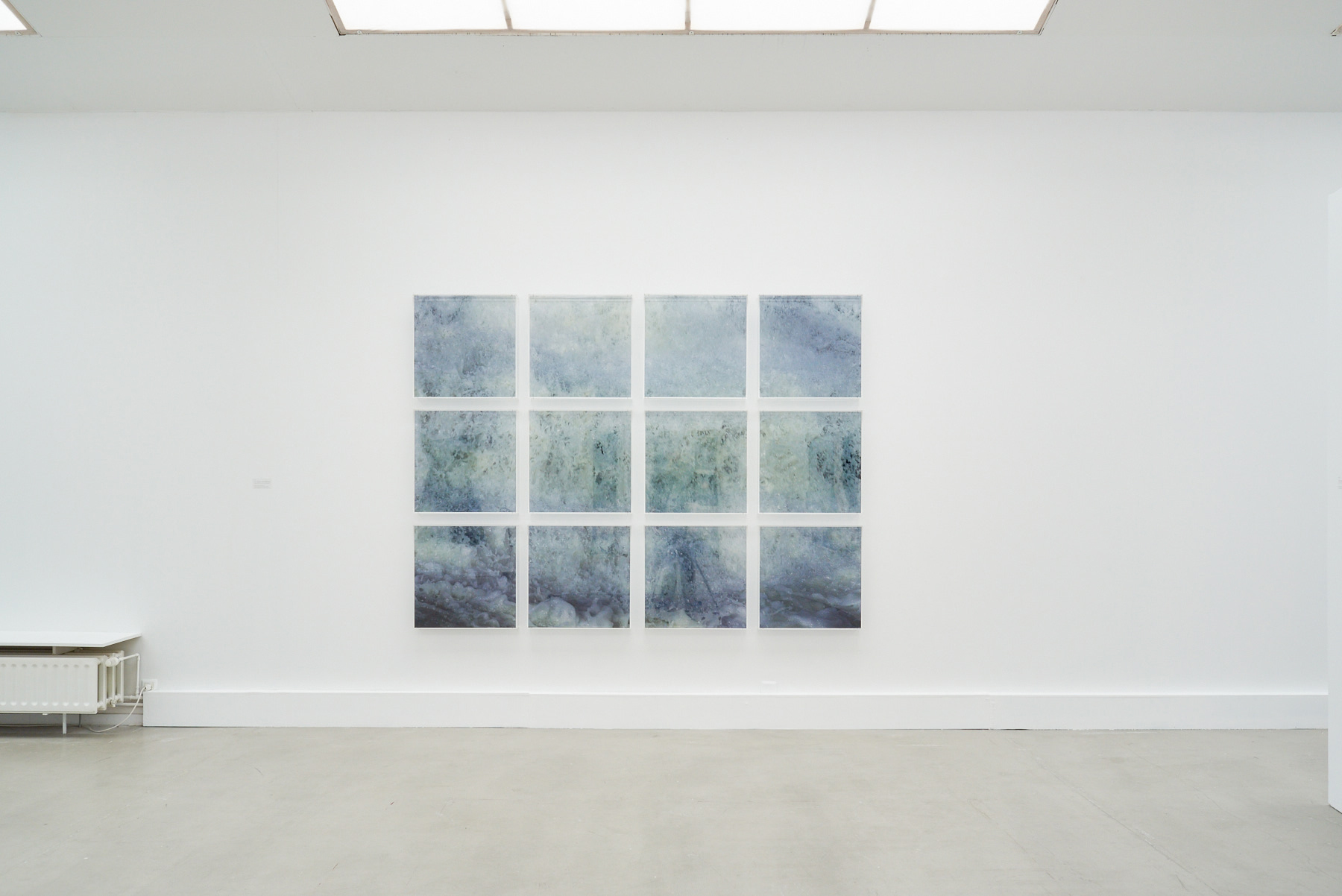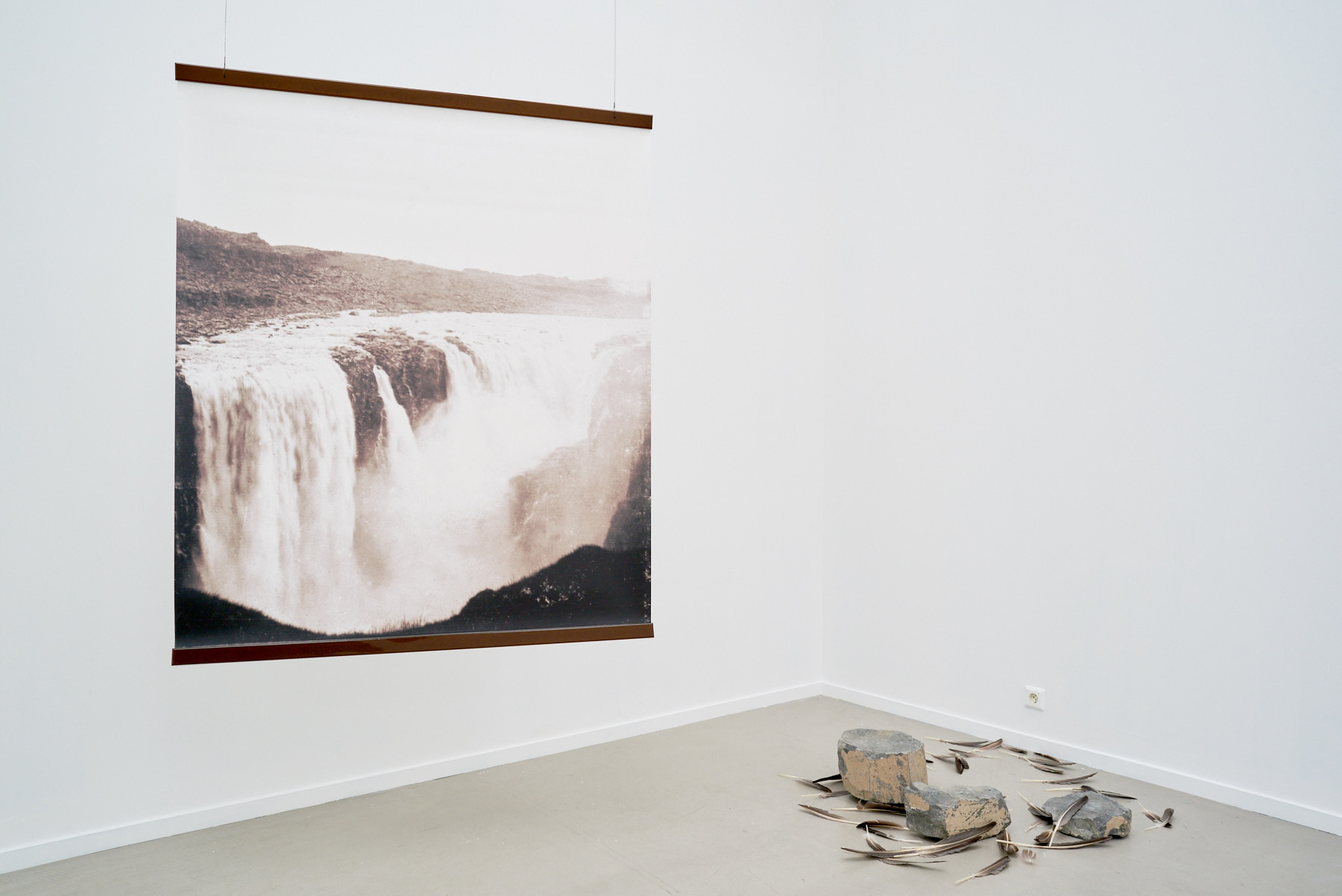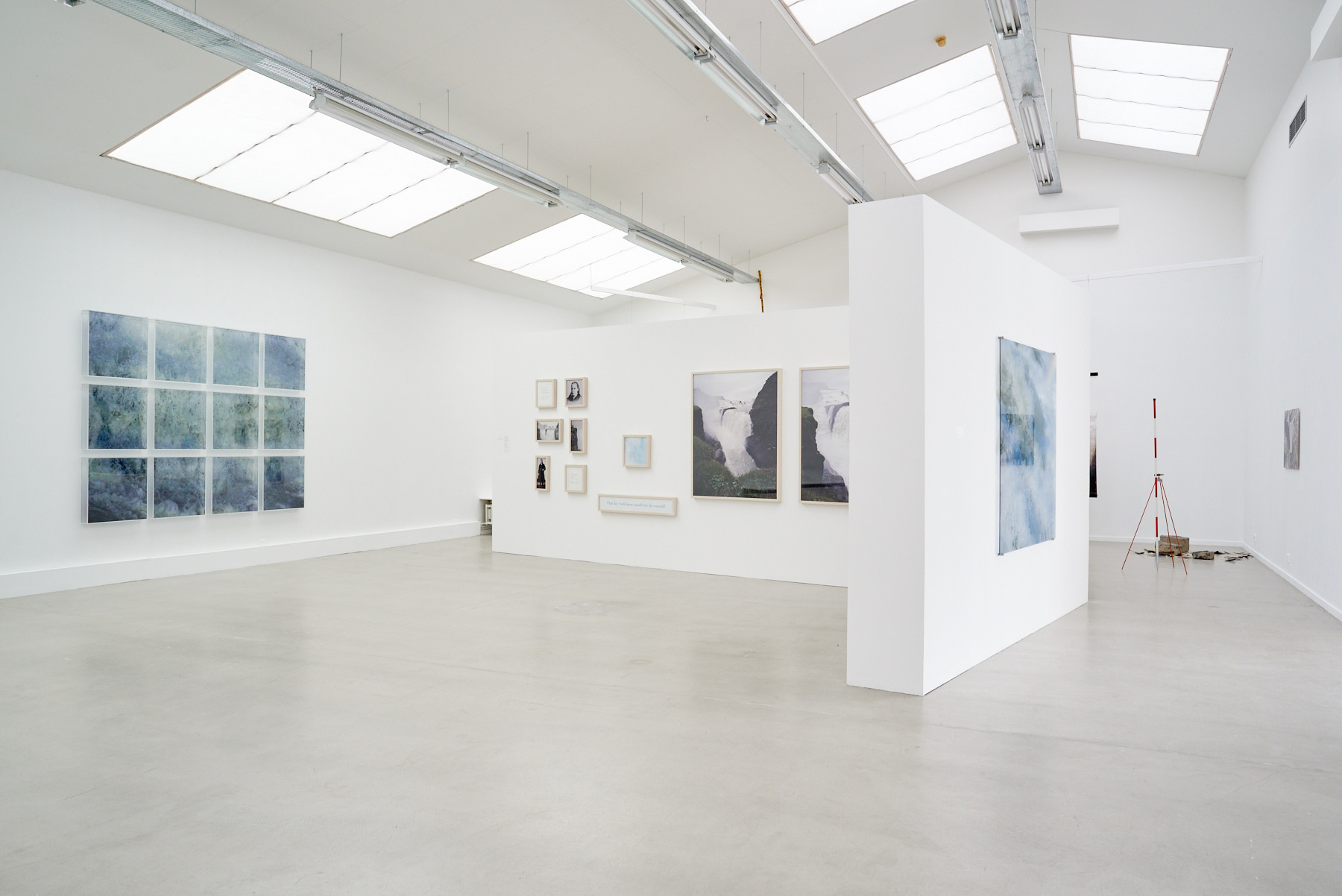
Time – Telling
Rúrí
May 14 – August 1, 2016
Laufey Helgadóttir
Art Historian
Time is the substance I am made of. Time is a river which sweeps me along, but I am the river; it is
a tiger which destroys me, but I am the tiger; it is a fire which consumes me, but I am the fire.¹
Rúrí’s first solo exhibition at Gallery Lóa in Amsterdam in 1979 included four works which addressed the theme of time. Among them was Time I-IV, which comprises four circular wall-clocks framed in white, which display a range of metaphors for time. The clock-faces have no numbers, and only one has conventional hands. The first has a golden arrow on the second hand, which rotates clockwise against a dark-blue face, around and around, displaying the eternal cycle of time. The next of the clocks also has a dark-blue face, against which are two symbolic spherical forms: an image of the sun attached to the hour hand and the earth on the minute hand. It thus shows, literally, the earth’s path around the sun, and the relative sizes of the two heavenly bodies. The third clock has no hands; the face is covered with a dark-blue disk, except for a glimpse offered through a triangular gap, showing a landscape at different seasons as the disc makes one 12-hour rotation. The fourth clock too has a disc instead of hands; in this case the disc is painted with the starry northern sky, with the Pole Star at the centre. The disc makes one rotation in 12 hours.
In addition to coming face to face with another definition of time than we are accustomed to in daily life, we gain, right at the beginning of Rúrí’s career, insight into her interest in astronomy, how time is measured, and the importance of viewing phenomena in a broad context, i.e. in relation to the universe. These are ideas which continue to be a major factor in her art, as seen here in the exhibition Time – Telling at the LÁ Art Museum. The timing of the exhibition relates to the installation of Rúrí’s open-air sculpture Sun Portal, which she has made for the Sólheimar ecovillage in south Iceland; and most of the works on display have some connection with the region. The title of the exhibition, Time – Telling, can refer both to chronology, i.e. methods of documenting events in time – and also to “telling” in the sense of a dialogue or discourse about the present time, focussing on political developments – as Rúrí herself has stressed.²
Over the centuries various different methods have been used to measure time, using the sun or stars, or seasons. Thus astronomy and the movements of heavenly bodies have been guiding mankind from time immemorial; and although today we have our clocks, watches and calendars, the stars are still reliable guides in the darkness.
Chronometers have not always existed, and the measurement of time as we know it today dates only from the period of the industrial revolution. But a clock can be unreliable; and even if we synchronise our watches we cannot be sure that they will show the same time a day from now. So which of them shows the “right” time? Is it possible that there are many times – no universal time?
This four-letter word stands for an invisible, intangible phenomenon that has captured the imaginations of scientists, artists, writers, historians and philosophers over the centuries – yet it remains a mystery today, in the same way as space and the universe are mysteries. But we know that time has to do with feelings, perceptions and the senses – and that individuals experience time in different ways. Scientists examine time through a different kind of lens from artists, who tend to see time as part of their daily existence, and hence they tend to have a more subjective and diverse sense of time. Thus time is manifested in the most multifarious ways in art. It may be creative and at the same time destructive; we may see it as energy, and it may also be a material to work with. Rúrí has said that she regards time as one of the elements.³
Some people ask themselves whether time is a physical dimension, whether it has a beginning and an end, what it means, whether it has a form, or whether it is simply an illusion. Others ask whether time passes, and how fast; and, if it passes, why does it progress from past to future, and not vice versa? Such questions were addressed by St. Augustine (354 – 430AD) in his Confessions: “What, then, is time? If no one asks me, I know what it is. If I wish to explain it to him who asks me, I do not know. Yet I say with confidence that I know that if nothing passed away, there would be no past time; and if nothing were still coming, there would be no future time; and if there were nothing at all, there would be no present time. But, then, how is it that there are the two times, past and future, when even the past is now no longer and the future is now not yet? But if the present were always present, and did not pass into past time, it obviously would not be time but eternity.⁴
And such questions remain valid today – for we know that it is as hard to grasp this extensive subject, time, as art itself. Time is sometimes said to be one of the two primary dimensions of existence – the dimension of change, the other dimension being space. According to Einstein’s Theory of Relativity, time and space are united into one space-time continuum or “spacetime.”⁵
The word time and space thus acquired new and altered meaning in the minds of many artists and hence it is no surprise that these two concepts often come up in discourse about the art of the 20th century and of today. We invariably speak of events taking place in time and space and on close scrutiny allusions to time may be discerned in all Rúrí’s oeuvre, along with contemplation of space, and the connections between them.
Time may constitute, for instance, the import of the work, its lifespan, or the way it changes and evolves – as for instance in the case of Sunlight II (1977) in which seeds were planted and grew, or Rainbow I (1983), which went up in flames in a matter of minutes or Rainbow II (1985), which gradually dissolved until nothing was left. Time may refer to the past, and even the future, as witness such pieces as Desolation (1984), made by Rúrí for the Flyvende Beton – Experimental Environment exhibition in downtown Copenhagen, Time/Pavilion made for Big Scale –’85 at the Malmö Arts Festival in Sweden, and Time Concrete, made in Helsinki in 1986 for another Experimental – Environment exhibition on the theme of Concrete. In making Desolation the artist had in mind devastated villages she herself had seen; on that basis she made a “ruined” building of concrete on Kultorvet, a busy Copenhagen square. The four-metre-high structures unquestionably called to mind the ruins of war-torn cities, in telling contrast to the surroundings. Time/Pavilion, based on the neoclassical Margareta Pavilion in Pildamm Park, one of Malmö’s public parks, resembled a ruined ancient Greek temple. Time Concrete was an allusion to a building on Iso Robertinkatu, a street in Helsinki where Rúrí’s work was also located. She used the forms of the original building in her work; hence the building referenced and the work itself comprise an indissoluble unit.
The subject of these three site-specific works, all addressing the theme of architecture in public spaces, is ruins and “future archaeology,” as the artist has pointed out. They tell us that we can learn from the past – and that we must also face up to our responsibility for the future. Manmade structures do not only fall prey to time and natural wear and tear: man himself may play the biggest part in the destruction. In this way the “ruin” works lead us to think about the ephemerality of cultures, and what may happen in the future. At the same time, Rúrí puts into tangible form her thoughts about time, which she described as follows in the context of the Helsinki work:
Time is constant
it continues whether there is anyone
to observe it or not,
changing and shaping environment and beings. Still, – time is not uniform.
Sometimes it is fast, sometimes slow, depending on circumstances,
states of mind and environment.
And time can be tangible when applied in its material dimension, as a yardstick of the changes that take place in the world. Cataloguing and measurement are recurring elements of Rúrí’s art, as for instance in her works on the theme of relativity made in the 1990s, in which she lends the immeasurable a measurable form through varying formal arrangements of wooden yardsticks (folding rulers). She asks whether phenomena such as love, affection and other emotions may actually be measurable. Such measuring techniques are in essence all concerned with the quest to find consistency and humanity’s place in the world. Rúrí grasped at an early stage the significance of the human body as a unit of measurement – for instance by studying Leonardo da Vinci’s famous Vitruvian Man, in which the human body is fitted within a circle and a square, with the navel at the centre. If the universe is a fixed quantity, man is a microcosm of that macrocosm. In that context Rúri has pointed out that in Leonardo’s drawing the man’s hair forms a perfect circle, “clearly a reference to the sun – as the position of the locks of hair suggests flames.”⁶
Time and the Sun
In her outdoor work Kuopio Observatorium, made in 1995 for the Experimental Environment exhibition in Kuopio, Finland, Rúrí addresses the measurement of time in connection with the changing position of the sun. She enlisted the help of an astronomer to calculate the precise direction of the sun at specific times. The work comprises six white concrete pillars of differing breadth, all about two metres in height. They form a circle 19 metres in diameter around a small square slab into which the four cardinal points of the compass (north, south, east, west) have been engraved. The pillars consist of three pairs – each indicating the direction in which sunrise and sunset may be seen from the slab at the summer and winter solstice and the spring and autumn equinox. The circular form of the piece recalls the sun itself, the horizon, and ancient stone circles such as Stonehenge in the south of England. But the circle can also signify the heavenly firmament, the signs of the Zodiac, and the unbroken cycle of time. “When I arrived in Kuopio last December in order to reconnoitre the site, it made a dark and gloomy impression. And that led me to decide to work with the sun in my piece,”⁷ explained Rúrí in a press interview.
That was not the first time that Rúrí had worked with the sun as her subject: in the 1970s she made Sunlight II (1977), a work quite different in nature. She took a small wooden box, filled it with earth and sowed it with cress seeds, with a bar of Sunlight soap in the lid. Above the box she displayed photographs illustrating the progress of the crop and the impact of time upon the growing-time of the piece. Two years later she did a performance art work, in which she worked with six canvases on six easels: on one she painted a yellow sun, then set fire to the sun so the flames rose upwards, scorching the canvas. She named the work Sunrise.
Observatorium Polaris, Rúrí’s proposal for an outdoor work on Islandsbrygge (Iceland Wharf) in Copenhagen, is another example of an environmental work of art based on the solar system and astronomy. The proposal is for eight pyramidal forms five to ten metres in height, topped with crystals which are intended to capture light by day and to light up by night. Tradition tells us that our Norse ancestors used “sun-stones” to navigate at sea when the sun and stars were hidden by clouds, long before the invention of the compass. Scholars have concluded that such sun-stones may have been clear crystals of calcite, Iceland spar,8 which has polarising qualities. Thus the crystal points at the top of the pyramids are an allusion to the sun-stones and serve to guide ships safely into harbour at the Iceland Wharf. Rúrí’s arrangement of the pyramids is based upon the Big Dipper or Plough part of the Ursus Major constellation and the relative positions of its stars and the Pole Star. Its illumination is calculated from the position of the observer.
For an artist on a constant quest for order and balance, the sun naturally plays an important role. The sun’s energy gives rise to all life on earth, and life, death and rebirth are symbolised by the solar cycle. While the sun is not God, as was a widespread belief in olden times, it remains for many a manifestation of the divine. The Ancient Egyptians named the sun after the king of their gods, Ra, while to the Greeks the sun was Helios, to the Romans Sol. And the high god of the Aztec civilisation in Mexico was the sun god, Huitzilopochtli. The Incas of Peru believed that they were descendants of the Sun God. And King Louis XIV of France took the sun as his emblem, identified with the sun god Apollo and called himself Le Roi Soleil (the Sun King). And so on: the symbolism of the sun is as diverse as it is contradictory.
When Rúrí was commissioned to make an outdoor work for the Sólheimar ecovillage, she knew immediately that she wanted to make a piece that related directly to the sun, and to the name of Sólheimar (sól=sun). And Sun Portal is an ode to the sun, planets, stars, and the universe. The work stands 7 m high; the longer side is 4.20 m and the shorter 2.80 m. It abounds in symbols and allusions. At a superficial glance it resembles a Mayan temple – or even an iceberg when seen from a distance in a certain light – where it marks the boundary of the village. The structure is of toughened glass supported by a stainless-steel framework and lit from within by lighting equipment which adjusts the brightness according to weather, daylight and the movements of heavenly bodies.
The space of the universe and the power of the sun are the materials and import of the work, which is both a spatial work and a waypost. In clear, bright weather, the surroundings and the sky are reflected in the surface of the work. “A passage through the work marks the line between sunrise at the summer solstice and sunset at the winter solstice. The line lies more-or-less between northnortheast and southsouthwest. According to ancient lore, that line signifies the year as an ideological whole, while also standing for the human life from the first breath to the last.”⁹
The piece has been made in collaboration with engineers, a lighting expert, an astronomer, a computer programmer, machinists and a landscape architect. The artist has said that the development of the work was profoundly influenced by her experience of the sincere affection and joy of the residents of Sólheimar – which is a mixed community of people with disabilities and without. Like other observers, Sólheimar residents can become participants in the work by going through the illuminated passage where they experience light, colour and form – or they can contribute it by making their own small tiles which will be embedded around the stone seats. It will also be possible to sit on the stone seats around the work, look up at the sky, watch the clouds drifting past, or simply let the mind wander. The stone benches form a projection of the Plough/Big Dipper, nearby stars, and the Pole Star.
Time and Water
To lie dreamily by a brook surrounded by nature, watching and listening as the water flows, gurgles and burbles by, must be one of the most delightful experiences we can have. The imagination is set free and we sense a subjective and physical bond with nature – and especially water, for the human body is mostly water. French philosopher Gaston Bachelard (1884-1962) has written more than others about the symbolism and lyricism of water – and also considered ideas about the activity and role of the imagination. He points out the importance of water in the context of imagination in his Water and Dreams, citing French writer Paul Claudel, who maintained that “water is the gaze of the earth, its instrument for looking at time.”¹⁰
In the early years of the 21st century water became one of Rúrí’s principal themes in her work, generally allied with a powerful sense of nature. Water is creative, and at the same time destructive, like time, and it is entirely possible to maintain that water and time are two aspects of the same phenomenon – as poet Steinn Steinarr did at the beginning of his much-read cycle of poems Tíminn og vatnið (Time and Water). Water has no beginning and no end, it circulates around and around like time, and it is part of the never-ending cycle propelled by the sun, which has been in motion since the birth of the earth. Water is one of the four elements in the ancient division into earth, air, fire and water – which often feature in our dreams. They were also traditionally seen as being manifested in the “humours” of human character: choleric, sanguine, phlegmatic, melancholic. Water is the source of all life, and without water there would be no life; yet it also provides the power that drives turbines, and is one of the most important resources of the earth. It is the wellspring of life, and at the same time has power of life and death – for it can flood, laying waste all in its path.
Rúrí has spoken in an interview of her close connection to nature, and her need to make a difference regarding nature conservation.
“When I later realised how much the ecosystem of the Þjórsá and other large rivers in Iceland had been encroached upon, and when a decision was made to construct in East Iceland the biggest hydro plant in Europe, my shock and horror mounted. I could not stand by and watch it happen. I had to get involved in the debate on the future of Icelandic nature. But I should clarify that I do not see the debate as specifically Icelandic, but as a branch of the international debate. I chose to work with Icelandic waterfalls, which I take as an example of what is happening all over the world, as hugely important natural phenomena are sacrificed in favour of mechanisation and industrialisation of various kinds – on such a scale that it poses a threat to the environment. In my works I condemn what is happening both in Iceland, and all around the world. Water symbolises nature as a whole – and in this context the hydro plants stand for all exploitation and development that disrupts the balance of nature and thus imperils the environment.”¹¹
As she states so clearly, Rúrí could not accept the Icelandic authorities’ assault on the ecosystems of the Þjórsá and other major rivers. In face of plans for hydro development at Eyjabakkar, which is inter alia an important breeding area for the pink-footed goose, a group of people eager to conserve the highland interior, led by Rúrí and actor Harpa Árnadóttir, organised a performance art work at the location on 4 September 1999. Over 100 people laid out on the ground 68 blocks of columnar basalt; into each was engraved one word of the Icelandic national anthem O guð vors lands by Matthías Jochumsson. On the first rock, near the Eyjabakkar ford, is the letter Ó, and the national anthem can be followed, rock by rock and word by word, along a three-kilometre route ending at a car park at the foot of Mt. Snæfell, where the poem culminates in the word deyr (dies). The performance, together with other public protests against planned hydro plants at Eyjabakkar and in Fljótsdalur, had sufficient impact that the authorities decided against this development. Instead, they embarked upon the dam and hydro plant at Kárahnjúkar.
After the Eyjabakkar performance Rúrí turned increasingly towards environmental issues – principally relating to water, and waterfalls endangered by hydro developments. And although her works take examples from Iceland, the artist regularly reiterates that these are simultaneously local and global issues.
In November of the same year Rúri made an installation in the Westman Islands, under the title That Day … The exhibition partly comprised documentation of the Eyjabakkar performance, including e.g. photographs of the rocks that made up the national anthem, fragments of columnar basalt, goose feathers from Eyjabakkar, a map, a theodolite and various survey instruments used when preparing land for development, as well as photographs of Sigríður Tómasdóttir from Brattholt, adjacent to the Gullfoss waterfall in south Iceland, who famously campaigned a century ago for the conservation of the waterfall. The title of the exhibition is drawn from Sigríður’s own words: she said that if Gullfoss were harnessed to generate electricity, “On that day I shall throw myself into the waterfall.” Sigríður’s words, demonstrating her courage and strong will in her campaign in defence of the waterfall, have been adopted by Rúrí as she follows in Sigriður’s footsteps. Sigríður has often been called Iceland’s first conservationist. Thus in her work Rúrí connects a major environ- mental issue of modern times with this historic event of the early 20th century while also honouring the memory of this remarkable woman. Three years later she made a photographic work, Dedication – to Sigríður of Brattholt (2002), comprising nine photographs developed on a white background and attached to a plexiglas backing. The images depict “pieces” of a waterfall, arranged as memory fragments.
Rúrí’s views on the environment and nature conservation were clearly elucidated in her exhibition in the Westman Islands and the work honouring Sigríður of Brattholt. In these she was, in a sense, preparing the way for later works, culminating in her interactive multimedia installation Archive – Endangered Waters, in which she focuses on waterfalls in the Icelandic interior which are in imminent danger due to hydro development projects – some of which have already been submerged under storage reservoirs for such plants. Archive – Endangered Waters, shown at the Venice Biennale in 2003, made a great impression – not only in Venice but also elsewhere in Europe – as it opened eyes to the violation of the natural environment entailed by hydro development.
While conservationists in Iceland went on protest marches and continued their resistance to hydro development, Rúrí made her views known through works in which she once again focussed on waterfalls at risk of obliteration, such as 400 Cubic Metres/Second (2003), a multimedia installation comprising two large photographic transparencies of Dynkur, a magnificent tiered cascade in the Þjórsá river, south Iceland. The sound of the falls is heard from speakers, or through headphones. At the time that Rúrí made the work, extensive harness- ing of the river was envisaged, which would have vastly diminished the water-flow over these beautiful waterfalls, with a devastating impact on their character. Shortly after this Rúrí made Waterfall – Dynkur, Endangered (2004 ) a wall-installation in which she cut up a photo- graph of one of the Dynkur waterfalls into 12 pieces, presented like consumer goods. While looking at the work the observer could listen to the waterfall’s “voice” through headphones. Waterfalls – these magnificent wonders of nature, with their unending, ever-changing song, play an ever-increasing part in Rúrí’s art – at the same time signifying the onward flow of time.
Dedication, a powerful performance piece carried out at Þingvellir by Rúrí on 5 September 2006 with a numerous team of helpers, also addressed the themes of time, memory and ephemerality. Performed in and around Drekkingarhylur (the Drowning Pool) at Iceland’s historic site of government and justice, the work was dedicated to Icelandic women and girls executed by drowning during the puritan 17th and 18th centuries for fornication, i.e. becoming pregnant and bearing children out of wedlock. The performance pointed a finger at society, highlighting the injustices perpetrated upon these women – and which women are still experiencing today.
Looking back over Rúrí’s career, it is seen to be a consistent cosmos in which philosophical questions, time, relativity, values, and humanity’s attitude to the universe are significant. Rúrí does not hesitate to confront the powers of the establishment: she invariably takes a political stance, and she is one of the few artists in Iceland who addresses issues of the impermanence of materialism and free-market ideology. She urges us to face our responsibility to the environment, to be more aware of our role on earth and how we deal with the future. We have more to learn and gain from her art than ever before.
Curator: Inga Jónsdóttir
Rúrí
Rúrí was born 1951 in Reykjavík, where she lives today. She studied art at the Icelandic College of Arts and Crafts 1971-74, metalwork at Reykjavík Technical College 1974-75 and art at the Stichting de Vrije Academie Psychopolis in the Hague, Netherlands, 1976-78. Rúrí became active and innovative as an artist and was one of the founders of Gallerie Lóa in the Netherlands and the Living Art Museum in Iceland. She has co-organized numerous art events in Iceland and abroad, such as the Experimental Environment, held in different Nordic countries and has held various positions of responsibility in the arts. Rúri has exhibited extensively, both solo and group exhibitions on national and international levels, and has made art for public places in Iceland and elsewhere in Europe. Her works have attracted attention, and are found in a number of private and public collections in Iceland and abroad. A comprehensive monograph, Rúrí, was published by Hatje Cantz in Germany in 2011, and she has also received a number of prestigious awards, such as winning first prize in sculpture competitions, and in 2003 Rúrí represented Iceland at the 50th Venice Biennale.
Her works are conceptual and realized in various media such as sculpture, installations, multimedia works, performances, book art, film, video, photographic works, sound works, mixed media, electronic and interactive work.




